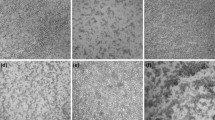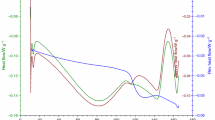Abstract
In this work, fennel oleoresin (FO) was encapsulated through freeze drying of the so produced emulsions within different edible biopolymeric carriers. Specifically, modified starch, maltodextrin, chitosan, and gum arabic were used as carriers both individually and in blends (binary and ternary ones). The freeze-dried FO products were characterized in terms of structure (X-ray diffraction (XRD) analysis), whereas their stability was studied by means of sorption isotherm analysis under various a w. Moreover, the formation of complexes was evaluated through Fourier transform infrared spectroscopy (FTIR) technique and ζ-potential analysis. The verification of the encapsulation process was also conducted by applying FTIR technique. Results showed that the final products presented an amorphous character, whereas the sorption isotherms could be described adequately by the Guggenheim-Anderson-de Boer (GAB) model. FTIR technique proved to be effective to confirm both the formation of complexes and the presence of FO into the studied carriers, verifying thus the success of the process.






Similar content being viewed by others
References
AOAC (2000) Official method of analytical chemists (17th ed.). Arlington, TX: The Association of Official Analytical chemists Inc.
Alves, S. F., Borges, L. L., dos Santos, T. O., de Paula, J. R., Conceição, E. C., & Bara, M. T. F. (2014). Microencapsulation of essential oil from fruits of Pterodon emarginatus using gum Arabic and maltodextrin as wall materials: composition and stability. Drying Technology, 32, 96–105.
Barras, A., Mezzetti, A., Richard, A., Lazzaroni, S., Roux, S., Melnyk, P., et al. (2009). Formulation and characterization of polyphenol-loaded lipid nanocapsules. International Journal of Pharmaceutics, 379(2), 270–277.
Beirão-da-Costa, S., Duarte, C., Bourbon, A. I., Pinheiro, A. C., Isabel, M., Januário, N., et al. (2013). Inulin potential for encapsulation and controlled delivery of oregano essential oil. Food Hydrocolloids, 33, 199–206.
Borrmanna, D., Pierucci, A. P. T. R., Leite, S. G. F., & da Rocha Leao, M. H. M. (2013). Microencapsulation of passion fruit (Passiflora) juice with n-octenylsuccinate-derivatised starch using spray-drying. Food and Bioproducts Processing, 91, 23–27.
Butstraena, C., & Salaün, F. (2014). Preparation of microcapsules by complex coacervation of gum Arabic and chitosan. Carbohydrate Polymers, 99, 608–616.
Calvo, P., Hernandez, T., Lozano, M., & Gonzalez-Gomez, D. (2010). Microencapsulation of extra virgin olive oil by spray-drying: influence of wall material and olive quality. European Journal of Lipid Science and Technology, 112, 852–858.
Chranioti, C., & Tzia, C. (2013). Binary mixtures of modified starch, maltodextrin and chitosan as efficient encapsulating agents of fennel oleoresin. Food and Bioprocess Technology, 6, 3238–3246.
Chranioti, C., & Tzia, C. (2014a). Arabic gum mixtures as encapsulating agents of freeze-dried fennel oleoresin products. Food and Bioprocess Technology, 7, 1057–1065.
Chranioti, C., & Tzia, C. (2014b). Thermooxidative stability of fennel oleoresin microencapsulated in blended biopolymer agents. Journal of Food Science, 79(6), C1091–C1099.
Chranioti, C., Nikoloudaki, A., & Tzia, C. (2015). Saffron and beetroot extracts encapsulated in maltodextrin, gum Arabic, modified starch and chitosan: incorporation in a chewing gum system. Carbohydrate Polymers, 127, 252–263.
Colthup, N. B., Daly, L. H., & Wiberley, S. E. (1990). Introduction to infrared and Raman spectroscopy (3rd ed.p. p. 319). San Diego, CA.: Academic Press, Inc..
de Oliveira, E. F., Paula, H. C. B., & de Paula, R. C. M. (2014). Alginate/cashew gum nanoparticles for essential oil encapsulation. Surfaces B: Biointerfaces, 113, 146–151.
Dong, Y., Ruan, Y., Wang, H., Zhao, Y., & Bi, D. (2004). Studies on glass transition temperature of chitosan with four techniques. Journal of Applied Polymer Science, 93(4), 1553–1558.
Espinosa-Andrews, H., Baéz-González, J. G., Cruz-Sosa, F., & Vernon-Carter, E. J. (2007). Gum Arabic-chitosan complex coacervation. Biomacromolecules, 8, 1313–1318.
Espinosa-Andrews, H., Sandoval-Castilla, O., Vázquez-Torres, H., Vernon-Carter, E. J., & Lobato-Calleros, C. (2010). Determination of the gum Arabic–chitosan interactions by Fourier transform infrared spectroscopy and characterization of the microstructure and rheological features of their coacervates. Carbohydrate Polymers, 79(3), 541–546.
Fernandes, R. V. B., Borges, S. V., Botrel, D. A., Silva, E. K., Gomes da Costa, J. M., & Queiroz, F. (2013). Microencapsulation of rosemary essential oil: characterization of particles. Drying Technology, 31, 1245–1254.
Greenspan, L. (1977). Humidity fixed points of binary saturated aqueous solutions. Journal of Research of the National Bureau of Standards Section A, 81, 89–102.
Hosseini, S. F., Zandi, M., Rezaei, M., & Farahmandghavi, F. (2013). Two-step method for encapsulation of oregano essential oil in chitosan nanoparticles: preparation, characterization and in vitro release study. Carbohydrate Polymers, 95, 50–56.
Kaasgaard, T., & Keller, D. (2010). Chitosan coating improves retention and redispersibility of freeze-dried flavour oil emulsions. Journal of Agricultural and Food Chemistry, 58, 2446–2454.
Kasaai, M. R. (2008). A review of several reported procedures to determine the degree of N-acetylation for chitin and chitosan using infrared spectroscopy. Carbohydrate Polymers, 71, 497–508.
Kaushik, V., & Roos, Y. H. (2007). Limonene encapsulation in freeze drying of gum Arabic–sucrose–gelatin systems. LWT- Food Science and Technology, 40, 1381–1391.
Kurek, M., Brachais, C. H., Nguimjeu, C. M., Bonnnotte, A., Voilley, A., Galic, K., et al. (2012). Structure and thermal properties of a chitosan coated polyethylene bilayer film. Polymer Degradation and Stability, 97, 1232–1240.
Labuza, T. P. (1984). Moisture sorption. In Practical aspects of isotherm measurement and use. Minneapolis. MN: The American Association of Cereal Chemists.
Lago, M. A., Sendón, R., Rodríguez-Bernaldo de Quirós, A., Sanches-Silva, A., Costa, H. S., Sánchez-Machado, D. I., et al. (2014). Preparation and characterization of antimicrobial films based on chitosan for active food packaging applications. Food and Bioprocess Technology, 7, 2932–2941. doi:10.1007/s11947-014-1276-z.
Lee, S. W., Kang, S. Y., Han, S. H., & Rhee, C. (2009). Influence of modification method and starch concentration on the stability and physical properties of modified potato starch as wall materials. European Food Research and Technology, 228, 449–455.
Lewicki, P. P. (1997). The applicability of the GAB model to food water sorption isotherms. International Journal of Food Science and Technology, 32(6), 553–557.
Lim, H. K., Tan, C. P., Bakar, J., & Ng, S. P. (2011). Effects of different wall materials on the physicochemical properties and oxidative stability of spray-dried microencapsulated red-fleshed pitaya (Hylocereus polyrhizus) seed oil. Food and Bioprocess Technology, 5(4), 1220–1227.
Lu, S., Song, X., Cao, D., Chen, Y., & Yao, K. (2004). Preparation of water-soluble chitosan. Journal of Applied Polymer Science, 91(6), 3497–3503.
Ludwiczak, S., & Mucha, M. (2010). Modeling of water sorption isotherms of chitosan blends. Carbohydrate Polymers, 79, 34–39.
Moschakis, T., Murray, B. S., & Biliaderis, C. G. (2010). Modifications in stability and structure of whey protein-coated o/w emulsions by interacting chitosan and gum arabic mixed dispersions. Food Hydrocolloids, 24, 8–17.
Murugesan, R., & Orsat, V. (2012). Spray drying for the production of nutraceutical ingredients: a review. Food and Bioprocess Technology, 5, 3–14.
Paula, H. C. B., Sombra, F. M., Cavalcante, R. F., Abreu, F. O. M. S., & de Paula, R. C. M. (2011). Preparation and characterization of chitosan/cashew gum beads loaded with Lippia sidoides essential oil. Materials Science and Engineering: C, 31(2), 173–178.
Peres, I., Rocha, S., Gomes, J., Morais, S., Pereira, M. C., & Coelho, M. (2011). Preservation of catechin antioxidant properties loaded in carbohydrate nanoparticles. Carbohydrate Polymers, 86, 147–153.
Pérez-Alonso, C., Beristain, C. I., Lobato-Calleros, C., Rodríguez-Huezo, M. E., & Vernon-Carter, E. J. (2006). Thermodynamic analysis of the sorption isotherms of pure and blended carbohydrate polymers. Journal of Food Engineering, 77(4), 753–760.
Pérez-Masiá, R., Lagaron, J. M., & Lopez-Rubio, A. (2015). Morphology and stability of edible lycopene-containing micro and nanocapsules produced through electrospraying and spray drying. Food and Bioprocess Technology, 8, 459–470. doi:10.1007/s11947-014-1422-7.
Rocha-Selmi, G. A., Bozza, F. T., Thomazini, M., Bolini, H. M. A., & Fávaro-Trindade, C. S. (2013). Microencapsulation of aspartame by double emulsion followed by complex coacervation to provide protection and prolong sweetness. Food Chemistry, 139(1–4), 72–78.
Rutz, J. K., Zambiazi, R. C., Borges, C. D., Krumreicha, F. D., da Luzb, S. R., Hartwig, N., et al. (2012). Microencapsulation of purple Brazilian cherry juice in xanthan, taragums and xanthan-tara hydrogel matrixes. Journal of Food Engineering, 108, 541–548.
Sanchez-Saenz, E. O., Perez-Alonso, C., Cruz-Olivares, J., Roman-Guerrero, A., Baez-Gonzalez, J. G., & Rodrıguez-Huezo, M. E. (2011). Establishing the most suitable storage conditions for microencapsulated allspice essential oil entrapped in blended biopolymers matrices. Drying Technology, 29, 863–872.
Shaikh, J., Bhosale, R., & Singhal, R. (2006). Microencapsulation of black pepper oleoresin. Food Chemistry, 94, 105–110.
Shigemasa, Y., Matsuura, H., Sashiwa, H., & Saimoto, H. (1996). Evaluation of different absorbance ratios from infrared spectroscopy for analyzing the degree of deacetylation in chitin. International Journal of Biological Macromolecules, 18, 237–242.
Shimada, Y., Roos, Y., & Karel, M. (1991). Oxidation of methyl linoleate encapsulated in amorphous lactose-based food model. Journal of Agricultural and Food Chemistry, 39(4), 637–641.
Sormoli, M. E., Islam, M. I., & Langrish, T. A. G. (2012). The effect of chitosan hydrogen bonding on lactose crystallinity during spray drying. Journal of Food Engineering, 108, 541–548.
Tatar, F., Cengiz, A., & Kahyaoglu, T. (2014). Effect of hemicellulose as a coating material on water sorption thermodynamics of the microencapsulated fish oil and artificial neural network (ANN) modeling of isotherms. Food and Bioprocess Technology, 7, 2793–2802. doi:10.1007/s11947-014-1291-0.
Tobitsuka, K., Miura, M., & Kobayashi, S. (2006). Retention of a European pear aroma model mixture using different types of saccharides. Journal of Agricultural and Food Chemistry, 54, 5069–5076.
Van den Berg, C., & Bruin, S. (1981). Water activity and its estimation in food systems. In L. B. Rockland & G. F. Stewart (Eds.), Water activity: influences on food quality (pp. 147–177). New York: Academic.
Wang, W., & Zhou, W. (2013). Water adsorption and glass transition of spray-dried soy sauce powders using maltodextrins as carrier. Food and Bioprocess Technology, 6, 2791–2799. doi:10.1007/s11947-012-0992-5.
Woranuch, S., & Yoksan, R. (2013). Eugenol-loaded chitosan nanoparticles: I. Thermal stability improvement of eugenol through encapsulation. Carbohydrate Polymers, 96, 578–585.
Xu, Y. X., Kim, K. M., Hanna, M. A., & Nag, D. (2005). Chitosan-starch composite film: preparation and characterization. Industrial Crops and Products, 21, 185–192.
Acknowledgments
Charikleia Chranioti is grateful to the State Scholarships Foundation of Greece (IKY) for financial support.
Author information
Authors and Affiliations
Corresponding author
Rights and permissions
About this article
Cite this article
Chranioti, C., Karamberi, A., Tsakanika, LA. et al. Freeze-Dried Fennel Oleoresin Products Formed by Biopolymers: Storage Stability and Characterization. Food Bioprocess Technol 9, 2002–2011 (2016). https://doi.org/10.1007/s11947-016-1773-3
Received:
Accepted:
Published:
Issue Date:
DOI: https://doi.org/10.1007/s11947-016-1773-3




